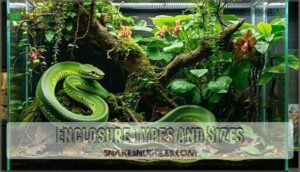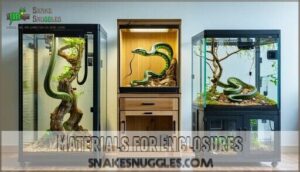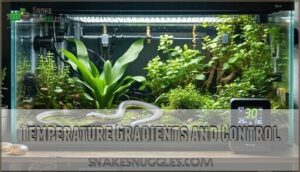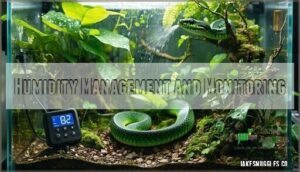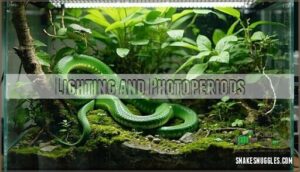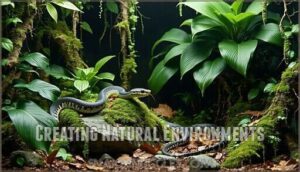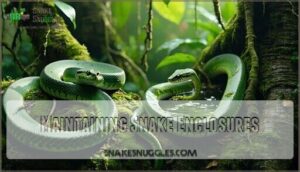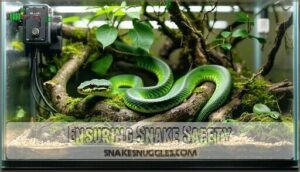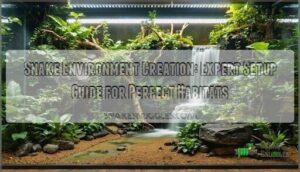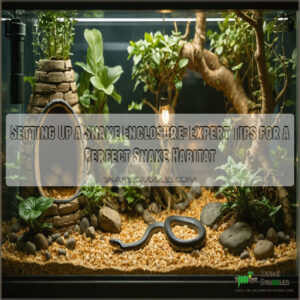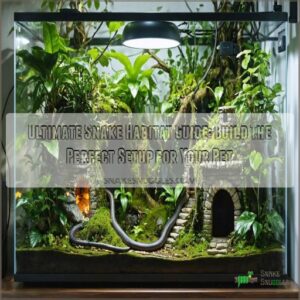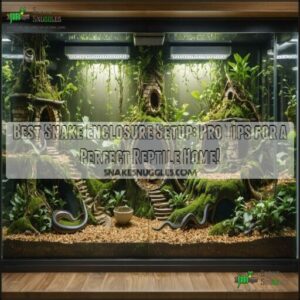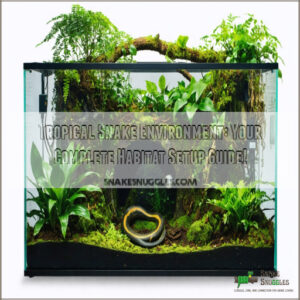This site is supported by our readers. We may earn a commission, at no cost to you, if you purchase through links.
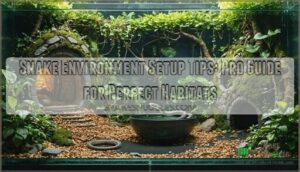
Create a temperature gradient using heating pads or ceramic heaters, maintaining cooler and warmer zones so your snake can thermoregulate naturally.
Choose substrates like aspen shavings or cypress mulch that allow burrowing and easy cleaning, and provide at least two hiding spots—one on each temperature side—along with a water bowl large enough for soaking.
Monitor humidity levels with a hygrometer, adjusting based on your snake’s species requirements, and consider the importance of lighting cycles and enrichment elements to transform a basic enclosure into a thriving habitat.
Table Of Contents
- Key Takeaways
- Choosing Snake Enclosures
- Setting Up Snake Habitats
- Creating Natural Environments
- Maintaining Snake Enclosures
- Ensuring Snake Safety
- Frequently Asked Questions (FAQs)
- How do I choose a snake habitat?
- How can you recreate a wild snake habitat?
- How do you make a snake habitat?
- How do you care for a snake’s enclosure?
- How do you keep a snake safe?
- How do you set up a snake enclosure?
- What is the best environment for a snake?
- What is the best setup for a snake?
- What kind of environment do snakes prefer?
- How often should I feed my snake?
- Conclusion
Key Takeaways
- Choose a secure enclosure that’s at least as long as your snake with proper ventilation, locking mechanisms, and materials like glass for easy cleaning and temperature retention.
- Create temperature gradients using heating pads or ceramic heaters to maintain warm zones (90-100°F) and cool zones (70-75°F) so your snake can thermoregulate naturally.
- Maintain proper humidity levels with a hygrometer and adjust based on your snake’s species—tropical species need 70-90% while desert species require 20-40%.
- Provide essential habitat elements including appropriate substrate for burrowing, hiding spots on both temperature sides, fresh water for soaking, and climbing structures for enrichment.
Choosing Snake Enclosures
Your snake’s enclosure serves as its entire world, so choosing the right setup means the difference between a thriving, healthy pet and one that’s stressed or sick.
Your snake’s home is their entire universe—get it right for a thriving, happy pet.
Whether you’re selecting a glass aquarium, custom terrarium, or specialized reptile cage, understanding size requirements, materials, and security features will help you create the perfect home for your scaly friend.
Enclosure Types and Sizes
When choosing your snake enclosure, you’ll find glass aquariums offer excellent visibility but lack proper ventilation for high-humidity species.
Terrarium size depends on your snake’s length—aim for enclosures at least as long as your snake.
Custom enclosures provide specialized vertical space for arboreal species, while bioactive setups create natural environments.
Juvenile enclosures can start smaller but plan for scaling needs. Remember to think about how enclosure size impacts health and consider the importance of a suitable environment for your snake’s overall well-being, including the need for proper ventilation.
Materials for Enclosures
Your enclosure materials determine your snake’s long-term health, so choosing wisely matters.
Glass vs. plastic offers different benefits, with glass providing better insulation and visibility.
Consider these material options:
- Glass terrariums – excellent visibility, easy cleaning, superior temperature retention
- Plastic enclosures – lightweight, affordable, good for beginners
- Metal mesh additions – enhance ventilation without wood concerns about rot
Custom materials allow personalized habitat designs, though cost analysis shows glass offers best value long-term for most snake enclosure setups.
For ideal safety, consider escape-proof lids and locks on any enclosure.
Ventilation and Security
Proper ventilation prevents stagnant air and mold growth while maintaining stable humidity levels.
Install intake and exhaust vents strategically, ensuring airflow design doesn’t create drafts.
Secure lids with reliable lock mechanisms are essential for escape prevention.
Choose barrier materials like reinforced mesh screening that provides ventilation without compromising security.
Material safety matters—avoid sharp edges that could injure your snake during inevitable escape attempts.
Setting Up Snake Habitats
Once you’ve selected your enclosure, creating the perfect habitat becomes your next priority.
You’ll need to establish proper temperature gradients, maintain appropriate humidity levels, and provide consistent lighting to keep your snake healthy and comfortable.
Temperature Gradients and Control
Temperature gradients create the backbone of snake health, allowing reptiles to regulate their body temperature naturally.
Set up your thermogradient setup with heating element types like under-tank heaters or ceramic emitters on one side. Your basking spot temp should reach 90-100°F while the cool side stays at 70-75°F.
Install temperature monitoring tools at both ends, and don’t forget thermostat calibration to prevent overheating.
Proper temperatures support essential metabolic processes, including digestion. Plan for gradient night drop of 5-10°F to mimic natural temperature cycles.
Humidity Management and Monitoring
With your temperature dialed in, humidity becomes your next challenge. You’ll want different levels depending on your snake’s origin – tropical species thrive at 70-90%, while desert dwellers prefer 20-40%.
A reliable hygrometer is your best friend for humidity monitoring. Misting systems provide consistent moisture, but substrate moisture from coconut fiber works wonders too.
For superior reptile care, consider a reptile misting system. During shedding, boost humidity temporarily to ensure a smooth process.
Regular hygrometer calibration guarantees accuracy and prevents mold prevention issues from excess moisture, which is crucial for the health and well-being of your snake.
Lighting and Photoperiods
Your snake’s internal clock depends on consistent lighting cycles.
Set up 12-hour day-night periods using timers for reliable circadian rhythm regulation.
UVB lighting benefits diurnal species by mimicking natural sunlight, while LED systems provide energy-efficient illumination.
Light automation eliminates guesswork, ensuring your snake maintains healthy behavioral patterns.
Consider seasonal variation adjustments to support natural cycles.
Creating Natural Environments
Creating a natural environment helps your snake feel secure and express natural behaviors.
You’ll need to carefully select substrates, hiding spots, and enrichment features that match your snake’s native habitat requirements.
Substrate Selection and Depth
Your reptile substrate choices lay the foundation for your snake’s health and natural behaviors.
Aspen shavings work perfectly for dry-climate species, while coconut husk and cypress mulch excel at humidity retention for tropical snakes.
Avoid cedar and pine due to substrate toxicity.
For burrowing species, maintain 3-4 inches depth to support natural digging behaviors.
Choose particle size carefully—fine substrates risk impaction.
Proper substrate depth prevents mold and enables thermoregulation.
Hiding Places and Decorations
Every snake needs a sanctuary where it can disappear from view.
Safe Hides should be snug, not spacious, with one opening that fits your snake’s body width.
Natural Decor like cork bark or commercial caves work best.
Place hiding places on both warm and cool sides.
Enrichment Items such as artificial plants add visual appeal.
Size Matters—hides should accommodate your snake’s entire body comfortably.
Cleaning Decor regularly prevents bacteria buildup in these essential retreats.
It’s important to keep in mind substrate depth guidelines for ideal comfort and to ensure your snake has a suitable environment.
Climbing Structures and Enrichment
Adding climbing structures transforms your snake habitat into a three-dimensional playground that encourages natural behaviors.
Branch placement should create multiple pathways using safe materials like cork bark or commercially treated wood.
Arboreal enrichment benefits both terrestrial and semi-arboreal species by providing exercise opportunities and behavioral diversity.
These enrichment options stimulate exploration, muscle development, and mental engagement, creating a dynamic snake habitat that mirrors snakes’ natural behaviors in the wild.
Maintaining Snake Enclosures
Creating a perfect snake habitat is just the beginning—maintaining that environment requires consistent attention and proper techniques.
You’ll need to establish regular cleaning routines, monitor environmental conditions daily, and make certain your snake always has access to fresh water and secure hiding spots.
Cleaning and Disinfection Methods
Your enclosure’s cleanliness directly impacts your snake’s health.
Spot clean waste daily to prevent bacterial growth.
Deep clean every 4-6 weeks using safe disinfectants like F10SC or 10% bleach solution.
Replace water bowls every 1-2 days for proper water sanitation.
Remove all accessories, scrub surfaces, rinse thoroughly, and make certain complete drying before returning your snake.
This routine maintenance prevents mold prevention and parasite prevention effectively.
Maintaining habitat hygiene is vital for preventing illness, and this routine is essential for the health of your snake.
Monitoring Temperature and Humidity
You’ll want to check your temperature and humidity levels daily using digital thermometers and hygrometers.
Place these monitors in different temperature zones to track gradients accurately. Digital hygrometers provide precise humidity readings, while thermostat calibration guarantees heating elements maintain proper temperature control.
Consider automated misting systems for consistent humidity monitoring, especially with humidity substrates like coconut husk that retain moisture effectively, and utilize digital hygrometers for precise readings.
Providing Fresh Water and Hides
Beyond temperature and humidity monitoring, your snake’s well-being depends on providing fresh water and secure hiding spots. These elements create a foundation for natural behaviors and stress reduction.
Consider these water and hide essentials:
- Water bowl size should accommodate your snake’s entire body, allowing complete submersion during shedding cycles while preventing drowning risks for smaller species.
- Hide material choice includes natural cork bark, commercial plastic caves, or ceramic decorations that offer complete darkness and snug-fitting spaces your snake can access easily.
- Number of hides requires at least two per enclosure – one on the warm side, one on the cool side, plus a humid hide near the watering area for ideal thermoregulation.
Position your water source location away from heating elements to prevent rapid evaporation. Cleaning frequency for water bowls should occur weekly or immediately after soiling. Fresh water supports hydration and humidity levels, while properly positioned hiding places reduce stress and encourage natural behaviors throughout your snake’s habitat.
Ensuring Snake Safety
You’ve built the perfect snake habitat, but safety measures are what truly protect your scaly friend from harm.
Proper security features, escape prevention, and safe handling practices guarantee your snake stays healthy while giving you peace of mind as a responsible reptile keeper.
Secure Lid and Locking Mechanisms
Your enclosure’s security depends on proper lid design and locking mechanisms. Snakes are skilled escape artists, so you’ll need robust safety measures.
| Lid Materials | Locking Types | Security Features |
|---|---|---|
| Screen mesh tops | Clips and latches | Multiple lock points |
| Glass sliding doors | Magnetic locks | Childproof mechanisms |
| Acrylic panels | Padlock systems | Weight-resistant design |
| Custom wooden lids | Spring-loaded bolts | Tamper-proof hardware |
Choose escapeproof lids with multiple locking mechanisms. Screen tops work well with secure clips, while glass enclosures need magnetic or sliding locks.
For sliding doors, consider using wire lock solutions. DIY security improvements include adding extra latches and childproofing enclosures with combination locks.
Preventing Escapes and Injuries
Even tiny gaps spell disaster for snake security, with nearly 70% of escapes stemming from inadequate enclosure sealing.
Inspect your setup regularly for cracks, loose panels, or mesh damage that could create new escape routes.
Check hiding spots for sharp edges that cause facial injuries, and make certain branches are securely anchored to prevent falls and lacerations.
Handling and Interaction Guidelines
Safe handling builds trust between you and your snake, reducing stress for both parties.
Trust grows through gentle movements and patience, not force.
Always wash your hands before and after interaction to prevent disease transmission. Move slowly and support your snake’s body when lifting—quick movements trigger defensive responses.
Watch for stress signs like hissing, striking, or hiding, which indicate your snake needs space. Limit handling sessions to 10-15 minutes, respecting your snake’s temperament and natural behavior patterns, to maintain a healthy and trustful relationship.
Frequently Asked Questions (FAQs)
How do I choose a snake habitat?
Choose an enclosure that’s at least twice your snake’s length with proper ventilation, secure locking lid, and materials like glass for easy cleaning.
Research your specific species’ size, temperature, and humidity requirements first.
How can you recreate a wild snake habitat?
You’ll recreate wild habitats by matching your snake’s native environment—use appropriate substrate, temperature gradients, hiding spots, climbing structures, and humidity levels that mirror their natural home.
How do you make a snake habitat?
Building a snake habitat is like constructing a custom home – you’ll need proper enclosure size, temperature gradient (75-90°F), humidity control, secure substrate, hiding spots, and consistent lighting cycles for peak health.
How do you care for a snake’s enclosure?
Daily enclosure maintenance involves checking temperatures and humidity levels, replacing fresh water, and spot-cleaning waste. Weekly deep cleaning includes changing substrate, sanitizing surfaces, and inspecting equipment for proper function.
How do you keep a snake safe?
Like a fortress guarding precious treasure, you’ll protect your snake by securing the enclosure with tight-fitting lids.
Maintaining proper temperatures between 75-90°F, and providing hiding spots for security and stress reduction.
How do you set up a snake enclosure?
Choose an enclosure that’s twice your snake’s length, maintain temperature gradients of 70-85°F with basking spots at 90-100°F, provide proper humidity levels, and include hiding spots.
What is the best environment for a snake?
Your snake’s habitat acts like a custom-tailored suit, fitting perfectly to its specific needs.
You’ll need proper temperature gradients (70-90°F), controlled humidity (40-80%), secure enclosure, and enrichment features for peak health.
What is the best setup for a snake?
Set up your enclosure with proper temperature gradients (70-85°F), secure hiding spots, appropriate substrate like aspen shavings, and maintain species-specific humidity levels using reliable monitoring equipment.
What kind of environment do snakes prefer?
You’ll want to create a temperature gradient with warm (80-85°F) and cool (70-75°F) zones.
Maintain proper humidity levels, provide secure hiding spots, and make certain adequate ventilation for your snake’s comfort.
How often should I feed my snake?
Like knights of old needed regular feasts, you’ll feed adult snakes every 1-2 weeks, juveniles weekly.
Monitor body condition, adjust portions accordingly, and never feed during shedding periods for peak health.
Conclusion
Perfect timing couldn’t have served you better, as creating an ideal snake habitat coincides with your reptile’s natural instincts for comfort and security.
These thorough snake environment setup tips guarantee your pet thrives in captivity. Remember that proper enclosure selection, temperature gradients, humidity control, and enrichment elements work together as a complete system.
Monitor conditions regularly, maintain cleanliness, and prioritize safety features. Your attention to these details creates a habitat that supports your snake’s health, natural behaviors, and overall well-being for years ahead.
- https://familysnake.com/guides/ssserenity-now-top-tips-for-crafting-your-snakes-relaxing-habitat/
- https://www.instructables.com/Snake-Enclosure-Set-Up/
- https://www.youtube.com/watch?v=-3zUSE8WrX4
- https://pmc.ncbi.nlm.nih.gov/articles/PMC8160691/
- https://responsiblereptilekeeping.org/cliffords-diadem-snake-husbandary-details/enclosure-size

